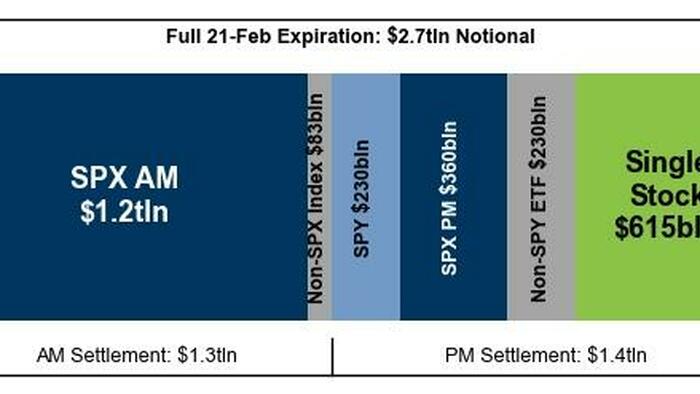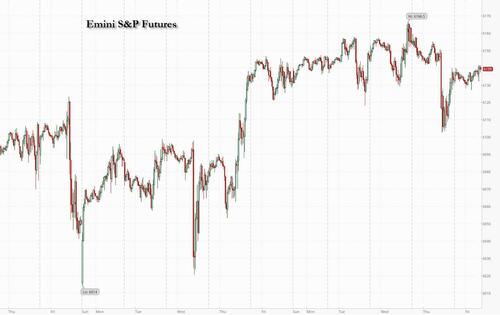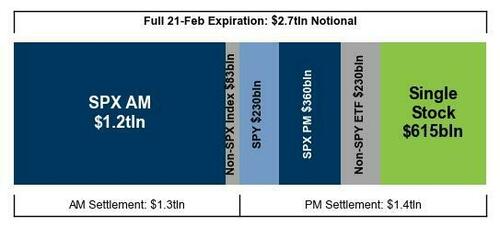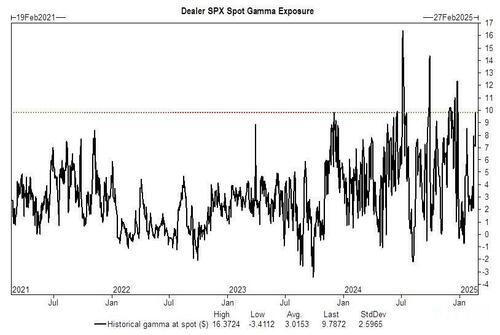


US equity futures are flat, as European and Asian markets rise, as sentiment improves on the last day of the week. As of 8:10am ET, S&P futures were unchanged at 6,138 after Walmart’s forecast and concerns about consumer behavior led to a decline in stocks Thursday; Nasdaq futures gained 0.3% with the Mag 7 names are mostly higher led by META +0.6%. US-listed Chinese stocks rose in premarket trading on Alibaba's post-earnings euphoria and after Treasury Secretary Scott Bessent said he would hold an introductory phone call with his Chinese counterpart, though he didn’t specify who on the Chinese side he’d speak to. Bond yields are 1-2bps lower and the USD is higher. Commodities are mixed: oil fell -0.8% this morning, while base metals are higher. From the macro perspective, overnight headlines were largely quiet; earnings results since market-close were mixed; BKNG announced 10% dividend increase and additional buybacks. Today, key macro focus will be global PMIs: the Mfg PMI is expected to print 51.4 vs. 51.2 prior; the Services PMI should print 53.0 vs. 52.9 prior.
In premarket trading, the Mag7 was little changed (GOOGL +0.2%, AMZN +0.2%, AAPL -0.07%, MSFT +0.3%, META +0.6%, NVDA +0.06% and TSLA -0.3%). US-listed Chinese stocks rise after Alibaba’s earnings offered a fresh boost to the China tech sector.Baidu (BIDU) +3%, JD.com (JD) +1.6%). Data center providers gained as Alibaba pledged to increase capital spending to support its AI ambitions. Dow Jones heavyweight UnitedHealth plunged more than 10% after the WSJ reported that the DOJ has launched an investigation into the company’s Medicare billing practices in recent months. The report cited people familiar with the matter. The Financial Times reported a high-level Japanese group had drawn up plans for Tesla to invest in carmaker Nissan. Here are some more premarket movers:
US equities have been lagging their European and Asian counterparts so far this year, and BofA CIO Michael Hartnett reiterated a preference for global stocks to US peers, seeing markets such as Germany, China, Japan and South Korea as more attractive at a time when business activity is improving. US companies’ profit outlooks for 2025 have also been relatively subdued, strategists at JPMorgan noted.
It is a quiet end to a turbulent week but we still have a huge, $2.7 trillion opex to go through. Goldman estimates that over $2.7 Trillion of notional options exposure will expire including $1.2 Trillion of SPX options and $615 Billion notional of single stock options, 9:30 AM Settlement: $1.3 Trillion ($1.2 Trillion is SPX AM), and $1.4 Trillion ($615 Billion single stocks).
Dealers are long +$9.787 Billion of S&P 500 gamma at current spot, acting as a market buffer, supporting weakness and muting rallies. The Goldman index trading team estimates that 50% of this long gamma position rolls off tomorrow, and the market will have the ability to move more freely next week (read our full preview here).
Traders are now looking ahead to Germany’s weekend election and hoping the results will allow the Conservative front-runner to forge a coalition that can push through economic reforms and loosen borrowing rules. If Europe’s biggest economy can spend more on defense, it may help calm a market rattled by Washington’s efforts to boost ties with Russia, they said.
In Europe, the Stoxx 600 Index added 0.6%, heading for its ninth consecutive weekly gain on the back of resilient profits and optimism over peace talks in Ukraine; chemical names as Air Liquide shares surged with analysts enthusiastic about their higher margin guidance. Standard Chartered leads outperformance in banks after confirming plans to hand back $1.5 billion more to shareholders. The German DAX index rises 0.2% ahead of Sunday’s election. European stocks enjoyed about $4 billion in inflows in the week through Feb. 19, the most since February 2022, according to a Bank of America Corp. note that cited EPFR Global data. Here are some of the biggest movers on Friday:
Earlier in the session, stocks in Asia rose, buoyed by a rally in technology shares as Chinese e-commerce giant Alibaba’s stellar results boosted investor sentiment. The MSCI Asia Pacific Index climbed 0.7%, supported by Alibaba along with Tencent, TSMC and Xiaomi. The regional gauge marked a sixth-straight weekly advance, rising 1.2% for the period, the longest winning streak in almost a year. Equities in Hong Kong and mainland China led gains around the region Friday. Alibaba shares jumped the most in nearly three years after it reported sales that beat estimates. The results were seen as a good sign for a continuation of the DeepSeek-driven rally in everything related to China’s AI sector, which helped push the Hang Seng Tech Index into a bull market earlier this month. Chinese technology stocks surged to their highest level since 2022, lifted by a 14% jump in Alibaba. Elsewhere in the region, Japanese stocks closed 0.3% higher after Bank of Japan Governor Kazuo Ueda said he expects easy financial conditions to support the economy. Shares saw notable gains in Taiwan and the Philippines.
In rates, treasury futures drifted higher with the curve flatter, supported by a drop in oil and wider gains seen across bunds which jumped on a notably weak French service PMI print for February although gains were tempered by more encouraging readings from Germany. German 10-year yields fall 4 bps to 2.49%. Gilts were largely unmoved by a UK PMI which came in close to expectations. UK 10-year borrowing costs are flat at 4.61%. Treasuries edge higher.
In FX, the Bloomberg Dollar Spot Index rose 0.2%, rebounding from 2025 lows with economists expecting the composite reading at 53.2, slightly below the January reading; the yen weakened 0.5% against the US dollar after BOJ Governor Ueda signaled a readiness to quell a surge in bond yields. The Japanese currency earlier touched a fresh 2025 high after inflation accelerated more than forecast. The euro falls 0.3% after purchasing manager data showed business activity in the region hardly grew in February, reinforcing fears that the bloc remains mired in stagnation.
In commodities, oil prices decline, with WTI falling 1% to $71.80 a barrel. Spot gold drops $8 to around $2,931/oz, but still headed for an eighth consecutive weekly advance as the geopolitical and trade tensions fueled demand for the precious metal.
The US economic data calendar includes February manufacturing PMI (9:45am), University of Michigan sentiment and January existing home sales (10am). Fed speaker slate includes Jefferson at 11:30am on central bank communication
Market Snapshot
Top Overnight News
A more detailed look at overnight markets courtesy of Newsquawk
APAC stocks traded mostly higher albeit with mixed price action seen following the subdued handover from Wall St where stocks declined amid geopolitical uncertainty, disappointing data and weak Walmart guidance, while participants in the region digested earnings releases and central bank commentary. ASX 200 marginally declined amid a deluge of earnings releases and after Australia's flash manufacturing PMI improved but remained in contraction territory, while RBA Governor Bullock reiterated a cautious approach to further rate cuts. Nikkei 225 swung between gains and losses with initial pressure owing to recent currency strength and after mostly firmer-than-expected CPI data, although the index then rebounded and the yen weakened amid comments from BoJ Governor Ueda who said if markets make abnormal moves, they stand ready to respond nimbly, such as through market operations. Hang Seng and Shanghai Comp are positive with notable outperformance in the Hong Kong benchmark which was led by a tech surge as Alibaba shares climbed by a double-digit percentage post-earnings, while the PBoC and Chinese Premier Li recently pledged efforts to smooth financing and stimulate consumption, respectively.
Top Asian News
European bourses (STOXX 600 +0.3%) opened with a modest positive bias, but sentiment slipped a touch, to display a more mixed picture. Thereafter, sentiment in Europe was hit following the release of the French PMI metrics, but the downside largely stabilised after the German and EZ figures. European sectors hold a positive bias, but with the breadth of the market fairly narrow aside from the day’s leader. Chemicals tops the pile, lifted by post-earning strength in Air Liquide (+2.9%). Energy resides at the foot of the pile, given the weakness in oil prices in today’s session.
Top European News
FX
Fixed Income
Commodities
Geopolitics: Middle East
Geopolitics: Ukraine
Geopolitics: Other
US Event Calendar
Central Bank Speakers
DB's Jim Reid concludes the overnight wrap
Five years ago today we all went home on the Friday night blissfully unaware of the way our lives would change by Monday, and then subsequently over the next couple of years. This weekend coming was when Covid cases started to rise exponentially in Italy and by Sunday night 11 Italian towns were in lockdown. The rest as they say is history. I'll do a CoTD today on global asset price performance since this point. So watch out for that. I wonder if in five years time we'll look back on this coming weekend as a pivotal moment in Europe (good or bad) given the German election.
We'll have a full preview of that below but a brief review of the last 24 hours first. We saw a moderate risk-off move yesterday, with the S&P 500 (-0.43%) falling back from its all-time high, whilst gold prices closed at a record $2,939/oz. This morning Chinese risk is doing well on the back of Alibaba'a earnings. The main story in the US was a weaker-than-expected forecast from Walmart, which added to nerves about the health of the consumer right now, especially after a soft retail sales print last week. So that dented confidence, but some nervousness is also setting in ahead of a pivotal German election this Sunday, which could have significant implications for European markets and geopolitics for years to come.
The election comes against a difficult backdrop for Germany right now, as their economy has just experienced two consecutive annual contractions over 2023 and 2024. Indeed its economy hasn't grown over the last 5 years which for one of the strongest nations in the world, is a major disappointment and big cause for concern.
Moreover, the vote itself is taking place several months earlier than planned, as it was called after the three-way coalition of the SPD, Greens and FDP collapsed late last year. There’s a big debate about what Germany needs to do to boost growth, and a large part of that has centred around whether the new government should pursue a more expansionary fiscal policy, and even reform the constitutional debt brake to allow for more spending.
As it stands, Politico’s polling average has the conservative CDU/CSU bloc in the lead on 30%, who are currently led by Friedrich Merz. They’re followed by the far-right AfD on 21%, Chancellor Scholz’s centre-left SPD on 16%, and the Greens on 13%. Then you’ve got several parties on the cusp of the 5% threshold to enter Parliament, including the Left who’ve seen a late surge up to 7%, with the far-left BSW and the free-market FDP both on 5% (other polling aggregates suggest a rounding down to slightly below 5% for BSW and FDP). It’s important to keep an eye on those parties around the 5% threshold, as small changes in vote share could have a big impact on coalition formation and how fragmented the new Bundestag will be. So here the outcomes become non-linear between 4.9% of the vote and 5.1%. Put simply if one of the fringe parties enters parliament it‘s likely that the centrist parties will still have a two-thirds majority that could allow them to change the debt break if they agree to. If two enter they are unlikely to have a two-thirds majority and the subsequent horse trading could prevent meaningful reform. See my CoTD from Wednesday here for more on this and page 14 of our German economics primer on the election here.
In terms of when we’ll get the result, the first exit polls will be at 6pm CET, but those still come with some margin of error (0.5pts in 2021). But projections based on actual votes will be released from 6:30pm and updated throughout the evening. So by 8pm, it’s likely that the projections will be firm enough to have a clear view on coalition options and whether the two-third centrist parliamentary majority is achieved.
After the vote, the question will then turn to coalition negotiations, but these can take anything from a few weeks to several months based on prior experience. Indeed, after the 2017 election, it took almost 6 months before a new government was formed, as the initial three-way talks between the CDU/CSU, the Greens and the FDP broke down, so another grand coalition was eventually agreed between the CDU/CSU and the SPD. But last time, it was a shorter 8 weeks between the election day and reaching an agreement.
In terms of what it means for policy, clearly that will depend on the sort of government that’s formed. But our economists think it’s plausible to assume a net fiscal easing of around 0.5% of GDP by 2026. Much of that’s likely to be from higher defence spending. And beyond that, they see an easing of the debt brake at the state level as likely, which could unlock substantial public investment and consumption with high multipliers.
Away from the German election, the main story of the last 24 hours, as discussed at the top, was a pullback in US equities, though this decline did ease somewhat as the session went on. By the close, the S&P 500 was down -0.43%, having been -0.97% lower early on. The decline followed a weaker-than-expected profit forecast from Walmart (-6.53%), who were the worst performer in the Dow Jones (-1.01%) as a result. Moreover, that followed a worse-than-expected US retail sales number last week, which showed the biggest monthly contraction (-0.9%) since March 2023. So putting all that together, it added to fears that growth might be losing momentum into the new year. With this backdrop, bank stocks were the biggest decliners within the S&P 500 (-2.97%), giving up some of the outperformance that had propelled the sector to a +11.7% YTD gain prior to yesterday’s decline. Elsewhere in Europe, the STOXX 600 (-0.20%) also lost further ground, leaving the index on course to post its first weekly decline of 2025 so far.
On the rates side, the risk-off tone pushed yields lower on both sides of the Atlantic. But the main headlines came from US Treasury Secretary Scott Bessent, who said that moves to increase longer-term debt sales were “a long way off”. So that helped to push down longer-dated Treasury yields, with the 10yr Treasury yield down -2.8bps on the day to 4.51% and overnight trading at 4.49% (-1.95bps) . By contrast, the 2yr yield was little changed (+0.1bps to 4.27%), in part amid hawkish-leaning Fedspeak, as St Louis President Musalem said that policy should stay “modestly restrictive until inflation convergence is assured” He further added that “Around this baseline scenario, the risks of inflation stalling above 2% or moving higher seem skewed to the upside”.
Over in Europe bond yields saw similar declines, with yields on 10yr bunds (-2.4bps), OATs (-2.3bps) and BTPs (-2.5bps) all falling back. And with the risk-off mood driven more by the US economic outlook than policy headlines, the euro closed above 1.05 against the dollar for the first time since mid-December as the broad dollar index (-0.75%) lost substantial ground.
Asian equity markets are mostly rising this morning with the Hang Seng (+3.21%) seeing a renewed rally after Alibaba has jumped +13.2% on the back of strong earnings, thus helping the index notch its longest winning run since January 2023. On the mainland, the Shanghai Composite (+0.77%) is also trading noticeably higher as Alibaba’s stellar earnings renewed confidence in China’s major tech stocks. Elsewhere, the Nikkei (+0.18%) is also trading slightly higher while the KOSPI is flat. S&P 500 (-0.08%) and NASDAQ 100 (-0.09%) futures are a little softer.
Early morning data showed that Japan’s inflation accelerated to hit a 2yr high, rising +4.0% y/y in January from +3.6% in the prior month. Core CPI also rose more than expected, reaching 3.2% y/y, a one-and-a-half-year high and a tenth above consensus but with core-core in-line. The latest readings ties further into the BOJ’s projections of higher inflation, which is expected to elicit more rate hikes from the central bank this year.
Earlier today, the BOJ Governor Kazuo Ueda signalled that the central bank stands ready to increase government bond buying if long-term interest rates rise sharply, reiterating the BOJ’s long-standing commitment to supporting stable markets. Following the statement, yields on the 10yr JGBs fell -2.0bps to settle at 1.42% after briefly touching a fresh 15-year high of 1.459% while the Japanese yen (-0.33%) fell below the 150 level against the US per dollar, retreating from 11-weeks high. Meanwhile, markets are pricing in a roughly 84% chance of a 25bps hike at the July meeting, up from a 70% chance at the start of the month.
Looking at yesterday’s other data, the US weekly initial jobless claims ticked up to 219k (vs. 215k expected) in the week ending February 15. In addition, the continuing claims for the previous week moved up to 1.869m (vs. 1.868m expected). Meanwhile in the Euro Area, the European Commission’s consumer confidence indicator moved up to -13.6 in February (vs. -14.0 expected), which is its highest level since October.
To the day ahead now, and data releases include the flash PMIs for February, UK retail sales for January, and in the US there’s existing home sales for January, along with the University of Michigan’s final consumer sentiment index for February. From central banks, we’ll hear from Fed Vice Chair Jefferson, the ECB’s Lane, and Bank of Canada Governor Macklem.



